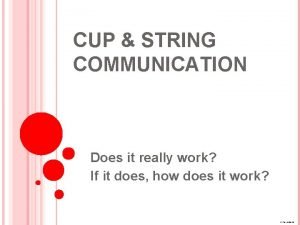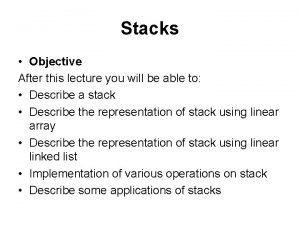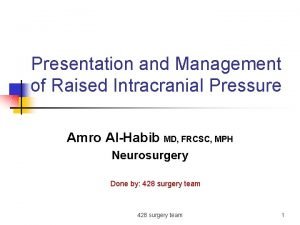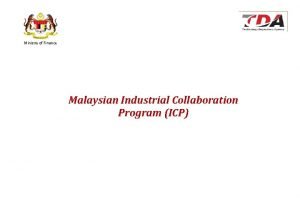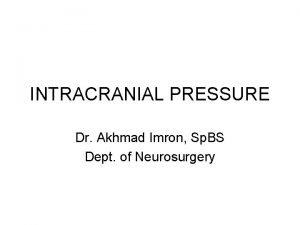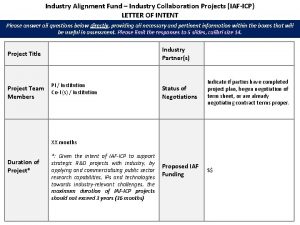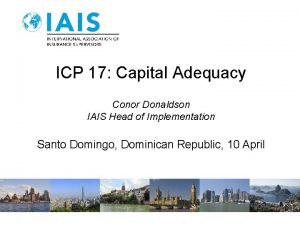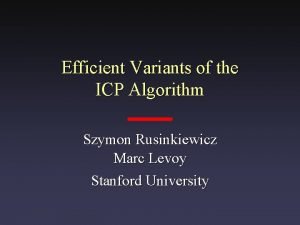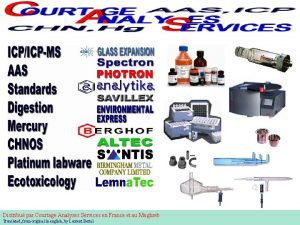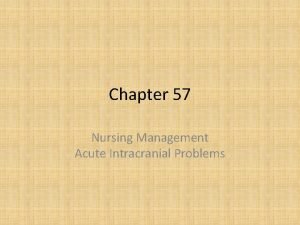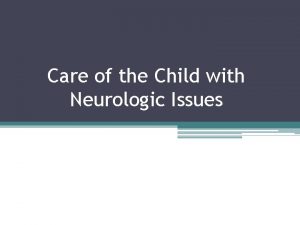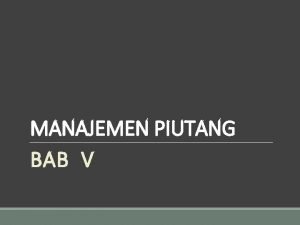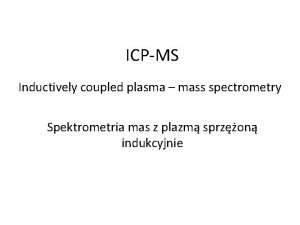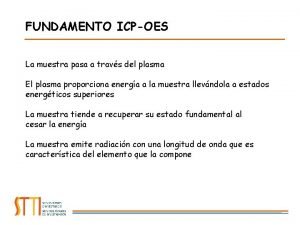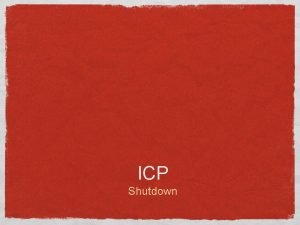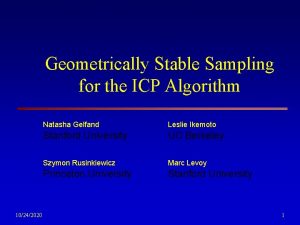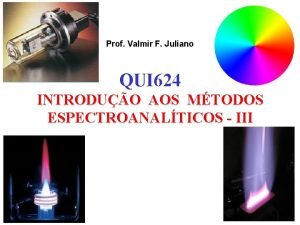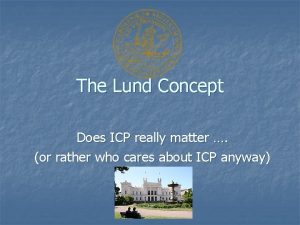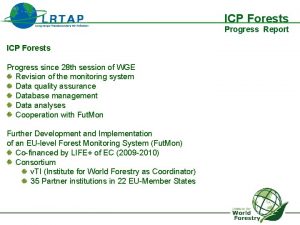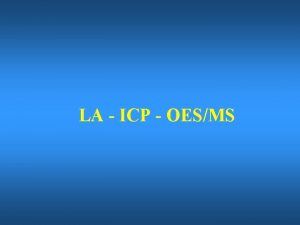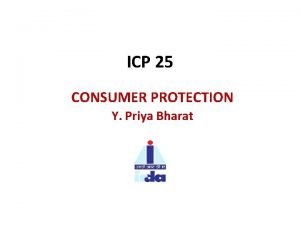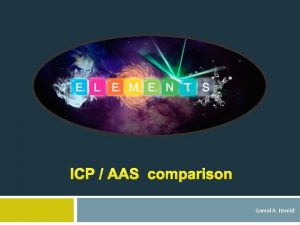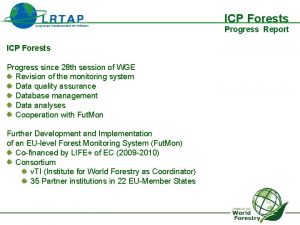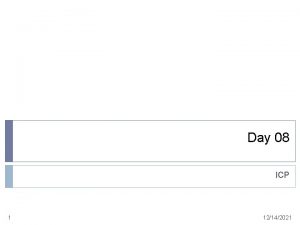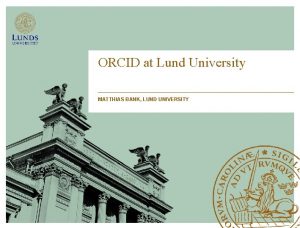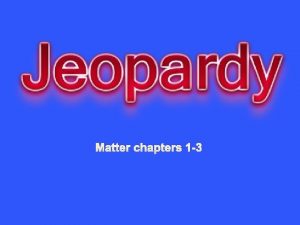The Lund Concept Does ICP really matter or




































- Slides: 36

The Lund Concept Does ICP really matter …. (or rather who cares about ICP anyway)


Approaches… n n n The Lund concept for the treatment of severe head injury was introduced in 1990 to 1991 at the University Hospital of Lund, Sweden. Conventional guidelines are based on meta-analytic surveys from clinical studies n maintenance of a relatively high CPP (the CPP-guided approach) n CPP = MAP – ICP. Lund therapy is a theoretical physiological approach n n physiological and pathophysiological hemodynamic principles of brain volume and brain perfusion regulation Tx of ICP and maintenance of cerebral perfusion n (the ICP and perfusion-guided approach).

The Lund Concept n relatively strict recommendations regarding n n n fluid therapy, optimal hemoglobin concentration, lung protection and temperature control, and risks and values of: n n n cerebrospinal fluid (CSF) drainage decompressive craniotomy Lund therapy has also been used for the treatment of brain oedema in meningitis.

Monro-Kellie doctrine n The pressure-volume relationship between ICP, volume of CSF, blood, and brain tissue, and cerebral perfusion pressure (CPP) is known as the Monro-Kellie doctrine or the Monro-Kellie hypothesis. n cranial compartment is incompressible & volume inside the cranium is a fixed volume n Blood, CSF, and brain in equilibrium n Principal buffers for increased volumes include both CSF and, to a lesser extent, blood volume. n Compensatory mechanisms- maintains normal ICP for volume change < 100– 120 m. L n v. intracranial (constant) = v. brain + v. CSF + v. blood + v. mass lesion n n Brain tissue (85%), cranial CSF (10%), cerebral blood (5%), spinal CSF is about 75 ml - cranial CSF volume

Why do we have CSF? n Functions of CSF n n n mechanical maintenance of a constant ionic environment - Ca, K, Mg and HCO 3 (active) and H and Cl by secondary transport. waste removal acid/base regulation via CO 2 nutritional and intracerebral transport

How’s it made CSF formation ~ 500 ml/day n CSF total volume 120 ml 70% from choroid plexus (blood vessels projecting into ventricles) - has tight junctions which means ultrafiltration (hydrostatic pressure) and secretion are important. n n n CSF hydrostatic pressure is 5 -15 mm. Hg Cilia help move CSF n to the 4 th ventricle and the foramina Lushka and Magendie n into the cisterna Magna then n into subarachnoid space around cerebella, n then further up to basilar cisterns n Lateral/frontal cerebral cortex.

Reabsorption n Reabsorbed via 1. arachnoid villi in sagittal and sigmoid sinuses, 90%, and 2. spinal arachnoid villi in dural sinusoids on dorsal root nerves, 10% n reabsorption is via pinocytosis and opening of intercellular spaces. n rate of reabsorption increases with CSF pressure. n resistance to reabsorption is normal until CSF > 22 mm. Hg and then it decreases.

The balance n n CSF formation and reabsorption is in equilibrium. BUT if ICP increases so much that CPP is <70 mm. Hg then CSF formation decreases. n If ICP<7 mm. Hg then minimal reabsorption occurs n CSF reabsorption is linear from 7 -70 mm. Hg

n n n In supine, healthy adults, normal ICP is between 7 and 15 mm. Hg. Term - normal ICP 1. 5 -6 mm. Hg Young children 3 -7 mm. Hg Adults n observational studies: ICP 20 -25 mm. Hg -> much poorer outcome from TBI The evidence is even more limited in children, but generally: n Infants <15 mm. Hg n Younger children <18 mm. Hg n Older children <20 mm. Hg.

Some physiology…. n Cerebral function is totally dependent on oxidative phosphorylation n glucose -> ATP. n Brain is 2% of body weight, but uses 20% of body's resting oxygen consumption. CBF varies with metabolic rates of the areas of the brain. n CBF and cerebral metabolism are thought to be coupled. n Local metabolic factors re coupling are n n n n n H+, K+, adenosine, phopholipid metabolites, glycolytic metabolites and nitric oxide. CBF ~ 750 ml/min

What’s autoregulation… n Autoregulation - phenomenon where CBF is kept constant over a MAP of 50150 mm. Hg. n >150 mm. Hg, then CBF passively increases with CPP and arterial pressure. n CBF increases linerarly by 2 -4% for every mm. Hg increase in Pa. CO 2 (between Pa. CO 2 of 20 -80 mm. Hg). n CO 2 diffuses rapidly across BBB, increases H+ in ECF and causes vasodilation. n BUT arteriolar tone modifies this effect and hence hypotension can abolish ability of cerebral circulation to respond to Pa. CO 2 changes. n n Pa. O 2 - if <50 mm. Hg then CBF will start to rise and doubles by time Pa. O 2 is 30 mm. Hg. Cerebral metabolic rate decreases by 7% for each 1 degree celsius in body temperature.

More physiology… n n Cerebrovasculature - well innervated by serotonergic, adrenergic, cholinergic nerves. Sympathetic activity can cause marked constriction of cerebral arteries - ie. in heavy exercise can stop high pressure from reaching small blood vessels and hence prevent haemorrhage. n Hypercarbia - get vasodilation. n Cerebral steal when decreased blood flow in ischaemic area of brain result in hypercarbic induced vasodilation in non-ischaemic areas. n Conversely, VC in normal areas of brain from hypocarbia can redistribute blood to ischaemic areas - i. e. Robin Hood or inverse steal phenomenon.

Last bit of physiology… n Starling's equation n the movement of fluid depends on six variables: Capillary hydrostatic pressure ( Pc ) n Interstitial hydrostatic pressure ( Pi ) n Capillary oncotic pressure ( πc ) n Interstitial oncotic pressure ( πi ) n Filtration coefficient ( Kf ) n Reflection coefficient ( σ ) n


Evidence…. Or lack of n Recent Chinese study n 68 patients, GCS 3 -8, severe HI 30 had The Lund Concept…. n Looked at 28 day mortality n n Roughly 30% vs 60% (p<0. 01)

Evidence… or lack of n Newcastle Uni – UK, … 2011 Critical care n MA Hamdan 1, K Dizdarevic 2, 1 Newcastle University, Newcastle upon Tyne, UK; 2 Clinical Centre University of Sarajevo, Bosnia and Herzegovina, Critical Care 2011, 15(Suppl 1): P 342 (doi: 10. 1186/cc 9762) n 60 patients – positive, p=0. 03

Concept n BBB disrupted after traumatic brain injury n cerebral autoregulation is impaired n hence, the transcapillary water exchange is determined by the differences in n n hydrostatic and colloid osmotic pressure between the intracapillary and extracapillary compartments. Induce transcapillary reabsorption of interstitial fluid by controlling transcapillary osmotic and hydrostatic differences n combination pharmacotherapy n n n b 1 -antagonist metoprolol a 2 -agonist clonidine low-dose thiopental dihydroergotamine maintenance of colloid osmotic pressure by PRBC and albumin

Mx n n n Alternatively, RICP ->reduction of CPP and CBF If persistent may worsen the primary brain injury and cause cerebral ischemia n Much variability in the practice of Tx of RICP and targets for ICP and CPP n Methods n focus on CPP and CBF Mx as the primary target n n n “CPP targeted therapy” Uses medications to increase CPP and CBF via increasing MAP Alternatively reduce ICP as the primary target n n “ICP-targeted therapy” to improve cerebral perfusion Lund Concept – a specific subcategory of ICP control involving a “volume targeted” strategy

Mx…. n n TREATMENT OF ICP ? high CPP -> improves oxygenation of injured brain n “squeezing blood through the swollen brain” reduces intracranial blood volume through an autoregulatory vasoconstrictor response. improved oxygenation maybe transient in injured brain n capillaries passively permeable to small solutes n n high perfusion pressure will induce transcapillary filtration and exacerbate edema and the autoregulatory response is weak after a brain injury.

n A passive venous collapse (resistance) is developed just inside the dura n protects brain from change in PV (i. e, head elevation or by PEEP) n n ↑ ICP from filtration (disrupted BBB) because of ↑ Pc and ↓ Ponc This ↑ -> partly transferred to capillaries with ↑ Pc and further filtration, etc n n -> new steady state Hence ICP ↑ >> initial increase in Pc or decrease in Ponc that started the filtration. n filtration -> ↑↑ ICP than increase in Pc or decrease in Ponc, triggering the filtration. n Hence, ↓ ICP >> ↓ Pc and ↑Ponc -> triggers ↓ ICP

Passise venous resistance vessel n Note slow process taking several hours n Vasoconstrictors – n n ↑ BP but also SE’s like n n ARDS and ↑ leakage of plasma -> hypovolemia and general tissue oedema; inotropes like dobutamine cause cerebral vasodilation…) (Lund patients don’t get these problems as much…. . )

The Lund concept… ICP n Accept a lower CPP than the initial recommended 70 mm Hg -> avoids vasopressors. n Antihypertensive treatment n n n Normalization of reduced Ponc may counteract filtration in brain n b-1 blockade, a-2 agonists, and ARB’s to counteract oedema Fluid therapy given in the Lund concept -> CPP will stay acceptable Hence higher CPP can be accepted without inducing transcapillary filtration i. e. albumin as the main plasma volume expander. Dihydroergotamine to reduce venous intracranial blood volume at significantly RICP n (no longer used due to decompressive craniotomy being more effective)

Blood volume expanders n A ↓ blood volume -> ? too low for adequate cerebral perfusion, especially in penumbra zone n Emphasis on avoiding hypovolemia-induced activation of the baroreceptor reflex n n n n Conventional guidelines have risk from concealed hypovolemia. Crystalloids not used b/c general tissue oedema (injured brain with a disrupted BBB) Albumin (? 20% solution) due to its more effective absorbing effect n beneficial to ↓ interstitial volume for both injured brain and rest of the body. Slow infusion rate of colloid results for longer effect Hence n relatively low arterial pressures, n avoidance of vasopressors, n maintenance of relatively normal Hb (transfuse upto Hb 120 for oxygenation/blood volume) n physiotherapy to stimulate the lymphatic drainage system, All reduce plasma leakage and the need for plasma volume expanders. albumin compared with saline trial ? explained by ↑ plasma leakage of albumin from vasopressors

To improve perfusion… n Perfusion depends on pressure & resistance. n Brain: a relatively low CPP can be compensated by an optimal fluid therapy. n n Confirmed by a microdialysis study on TBI pts treated by Lund concept n This study showed improved oxygenation, greater blood flow, and less tissue degradation, despite reduced arterial pressure with antihypertensive therapy, by measurement of the interstitial lactate/puruvate ratio, glycerol, glucose, and glutamate in the penumbra zone. The results can be explained by avoidance of noradrenalin-induced vasoconstriction and plasma leakage and by avoidance of low hemoglobin concentrations. n These data support the view that adequate blood volume is more important for oxygenation of the penumbra zone than high CPP. n CPP stays in the range of 60 to 70 mm Hg in most adult patients treated with the Lund therapy n Can accept a minimum CPP of 50 mm. Hg if otherwise optimal fluid therapy n CPP values down to 38 -40 mm Hg are accepted in small children.

Osmotherapy n Not used n n n ICP-reducing effect is transient n n n lack of scientific and physiological support documented side effects. mannitol and urea often has rebound increase in ICP some hours after the infusion aggravating the brain edema. Mannitol may also be associated with renal insufficiency and severe electrolyte disturbances. Exception: n Osmotherapy, especially HTS maybe for acute control (ED/ambulance)

Lung function n The Lund concept includes some specific lung-protective measures n Vasoconstrictors and high-dose barbiturate therapy are associated with pulmonary complications in terms of ARDS, pneumonia, and high fever - better n Positive end expiratory pressure (PEEP) is used extensively n reduce atelectasis n controversial in head-injured patients due to the potential risk of increasing ICP by an increase in venous pressure. n Experimentally shown that brain in rigid shell- variable passive venous outflow resistance, provided that the tissue pressure is above the venous pressure outside the shell n hence moderate PEEP (5 to 8 cm H 2 O) is safe. n Inhalations and moderate bagging (under ICP control) are other lung protecting measures recommended in the Lund therapy. n Avoid crystalloids - plasma volume expanders may ↓ risk of lung oedema. n Severe ARDS is very rare in patients with an isolated head injury who are treated according to the Lund concept. n Hyperventilation is not used due to aggravation of hypoxia in the penumbra zone

Anti stress therapy n Barbituates decrease ICP by decreasing cerebral metabolism, CMRO 2 and hence CBF and CBV n Wake-up tests are not used due to stress effects (results in ↑ICP) and release of catecholamines (may reduce brain perfusion) n Heavy sedation n n midazolam and analgetics in combination with clonidine sometimes short-term treatment with a low dose of pentobarbital Sedatives continued until ICP stabilized at a normal level and until weaning from the ventilator will be successful. A beneficial effect of this sedation regime is the lack of epileptic seizures, which means that there is no indication of prophylactic anticonvulsary treatment.

Temperature n n Fever stimulates cerebral metabolism and induces vasodilation Active cooling not used n n potential side effects inherent in the significant stress and catecholamine release risk of reducing cerebral circulation of the penumbra zone. The Lund therapy involves treatment of high fever pharmacologically Steroids (methylprednisolone) n n Controversial due to SE’s (adrenal suppression, effects on catecholamine synthesis, decrease NO production>? vasoconstriction) CRASH trial showed adverse outcome with high dose steroids

Drainage of CSF/decompressive craniotomy n Drainage of CSF ↑ transcapillary pressure in the brain due to ↓ tissue pressure inducing filtration. n Loss of CSF volume ->replaced by more oedema with risk of ventricular collapse. n The risk can be reduced if the drainage is performed from a relatively high pressure level and if ventricular volumes are evaluated by computed tomography controls. n n Under such circumstances, CSF drainage is accepted in the Lund concept to control a raised ICP (only through ventricular drainage), especially if there are signs of hydrocephalus. Decompressive surgery in terms of craniotomy and evacuation of hematomas and available contusions are options in the Lund therapy. n lack of studies -> decompressive craniotomy is controversial n SE of craniotomy is strangulation in the cranial opening due to herniation. n As the protuberance at least partly can be explained by transcapillary filtration due to loss of counter pressure in the cranial opening, antihypertensive treatment, and a relatively low CPP, in combination with normal plasma oncotic pressure, as favored in the Lund concept, may reduce adverse effects of craniotomy. n Decompressive craniotomy is the last therapeutic measure to prevent brain stem herniation in Lund therapy

Other controversies n Prostacyclin to improve microcirculation has been recently added n General quality of care has improved n n n Local variations in tissue pressure and hence perfusion pressure n Maybe the injured areas needs a higher CPP, but achieving this results in oedema…. Reducing catecholamines may prevent their escape across BBB which increased cerebral metabolism and O 2 consumption Is oncotic pressure as important as Lund therapy emphasises

Summary: n Basic concept is normalisation of various parameters n n n fluid therapy, Hb lung protection temperature control Potentially: n n n cerebrospinal fluid (CSF) drainage decompressive craniotomy Other n Normalisation of Pa. O 2, Pa. CO 2, enteral nutrition, avoidance of overnutrition

From APIC volume 2, (Antonino Gullo) Goal Target Intervention Decreased capillary hydrostatic pressure CPP 60 -70 mm. Hg Metoprolol, clonidine, dihydroergotamine Reduce cerebral blood volume ICP <25 mm. Hg Thiopentone, dihydroergtamine Reduce CMRO 2 and stress response Sedation and analgesia BDZ, fentanyl, thiopentone Maintain blood volume and colloid osmotic pressure Normal Hb, albumin, equal fluid balance Albumin, frusemide, blood, nutrition Intermittent CSF drainage ICP <25 mm. Hg EVD

Our current protocol… n Maintain cerebral perfusion pressure (CPP) > 60 mm. Hg using noradrenaline regardless of ICP. Ensure normovolaemia eg. CVP 8 -12 mm. Hg and/or Δdown < 5 mm. Hg Maintain Hb close to 100 g/l. Maintain p. O 2 > 100 mm. Hg (check ABG if Sp. O 2 < 98%) &Maintain p. CO 2 36 -40 mm. Hg. Monitor ETCO 2. continuously if an Evita ventilator with capnography is available. Aim for ETCO 2 3035 mm. Hg Sedation 7 -14 mls/hr of standard M&M for a 70 kg patient. Nurse 20 -30 o head up – tilt the whole bed if the spine has not been cleared. Ensure that ETT tapes are not causing jugular venous obstruction. Control BSL as per unit protocol. Monitor temperature continuously aiming for normothermia. Give paracetamol if T > 37. 5 o. C More aggressive maintenance of normothermia with ice can be used at the discretion of the duty intensivist Saline or Hartmann’s should be used as maintenance fluid aiming for Na+ > 140 mmol/l. Do not use dextrose solutions. n General n n n n n Early enteral nutrition as per ICU protocol. Stress ulcer prophylaxis – ranitidine 50 mg tds IV. DVT prophylaxis as per ICU protocol. TEDs and calf compressors initially, Frequent position changes and chest physiotherapy. Bowel care as per unit protocol.

Our current protocol n n n n Intracranial hypertension needs to be treated when ICP > 20 -25 mm. Hg for greater than 5 minutes. Aim to “control” ICP < 20 mm. Hg ideally. ALL PATIENTS: Ensure basic management measures are in place as above. Ensure that CPP is maintained > 60 mm. Hg with noradrenaline. Optimise sedation. morphine/midazolam. Bolus of muscle relaxant Ensure normothermia. Osmotherapy: Mannitol: If Na+ < 155 mmol/l and CVP > 12 mm. Hg HTS: If Na+ < 155 mmol/l and CVP < 12 mm. Hg, give 30 ml of 23. 4% saline Expect a decrease in ICP within 20 -30 minutes. Repeat CT scan to exclude a surgically remediable lesion and generally follow the evolution of the injury.

Would I recommend it… n n Physiologically, it makes sense But without adequate evidence and general lack of use elsewhere…
 Doesnt really matter
Doesnt really matter What's the matter you look really tired
What's the matter you look really tired Does the cup and string work
Does the cup and string work Classification of matter section 1 composition of matter
Classification of matter section 1 composition of matter Gray matter
Gray matter Section 1 composition of matter
Section 1 composition of matter Chapter 2 section 1 classifying matter answers
Chapter 2 section 1 classifying matter answers Label the cranial dura septa and associated sinuses.
Label the cranial dura septa and associated sinuses. Composition of matter section 1
Composition of matter section 1 Gray matter and white matter
Gray matter and white matter Matter
Matter Flow of energy vs flow of matter
Flow of energy vs flow of matter Isp icp postfix
Isp icp postfix Signs and symptoms of increased icp
Signs and symptoms of increased icp Icp waveforms a b c
Icp waveforms a b c Icp policy
Icp policy Mannitol for icp
Mannitol for icp Infratentorial
Infratentorial Iaf icp
Iaf icp Conor donaldson
Conor donaldson Efficient variants of the icp algorithm
Efficient variants of the icp algorithm Efficient variants of the icp algorithm
Efficient variants of the icp algorithm Geicp
Geicp Normal icp
Normal icp Cushing triad syndrome
Cushing triad syndrome Icp primaria
Icp primaria Icp ms
Icp ms Ccc icp
Ccc icp Icp ms metoda
Icp ms metoda Icp-oes fundamento
Icp-oes fundamento Icp fast parts 1184422
Icp fast parts 1184422 Aetna better health icp
Aetna better health icp Isp icp postfix
Isp icp postfix Icp reboot
Icp reboot Geometrically stable sampling for the icp algorithm
Geometrically stable sampling for the icp algorithm Icp das co. ltd
Icp das co. ltd Icp
Icp


